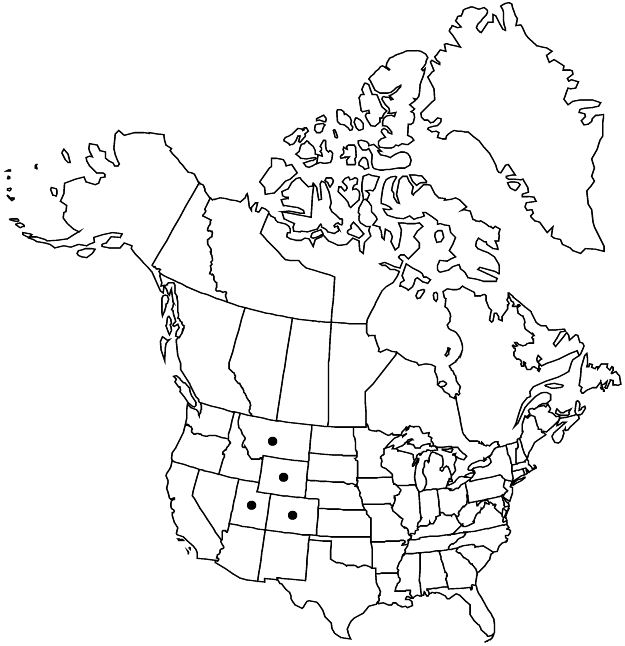Potentilla saximontana
Bull. Torrey Bot. Club 23: 399. 1896.
Stems (0.2–)0.4–1(–1.5) dm. Basal leaves subpalmate to pinnate, (1–)1.5–4(–7) cm; petiole 0.5–2(–4) cm, vestiture not or scarcely seasonally dimorphic, long hairs abundant to dense, appressed to spreading, 1–1.5(–2) mm, weak to ± stiff, cottony hairs usually absent, crisped hairs absent or sparse, glands sparse; leaflets 3 at tip of leaf axis plus 1–2(–3) additional pairs separated from tip by 1–5 mm, on distal 1/10–1/3 of leaf axis, largest leaflets obovate to oblanceolate, 0.5–1.5 × 0.3–1.2 cm, ± whole margin incised 1/2–3/4 to midvein, teeth 2–4(–5) per side, separate to overlapping, 1–4 mm, surfaces ± dissimilar, abaxial grayish green to white, straight hairs abundant, 1–1.5 mm, cottony and crisped hairs sparse to dense, rarely absent, glands sparse or obscured, adaxial green to grayish, straight hairs sparse to abundant, 1–2 mm, cottony hairs absent or rarely sparse, crisped hairs absent or sparse, glands ± sparse. Cauline leaves 0–1(–2). Inflorescences (1–)2–5(–10)-flowered. Pedicels 0.5–1.5 cm (proximal to 2.5 cm). Flowers: epicalyx bractlets ± ovate-elliptic, 2–4 × 1–1.5 mm; sepals 3.5–5 mm, apex bluntly acute; petals 4–6(–8) × 4–7 mm; filaments 0.5–2 mm, anthers 0.5 mm; carpels 10–20+, styles columnar-filiform, papillate-swollen at base, if at all, 0.8–1.5 mm. Achenes 1.5 mm.
Phenology: Flowering summer.
Habitat: Alpine tundra and meadows, rocky slopes, talus
Elevation: 3200–4100 m
Distribution

Colo., Mont., Utah, Wyo.
Discussion
Potentilla saximontana is a small plant of very high elevations in the mountains of Colorado, the La Sal and Uinta mountains of Utah, and the Absaroka and Beartooth mountains of Wyoming and Montana. Although sometimes confused with P. rubricaulis (for example, W. A. Weber and R. C. Wittman 1996), the subpinnate leaves, open few-flowered inflorescences, and columnar-filiform styles make P. saximontana a distinct species.
The lectotype of Potentilla nivea Linnaeus var. dissecta S. Watson [= P. saximontana var. dissecta (S. Watson) Soják] has been tentatively included in P. saximontana (B. Ertter 2008), but P. saximontana is not otherwise known from the Canadian Rockies. See B. Ertter et al. (2013) for additional discussion.
The combination Potentilla rubripes Rydberg var. saximontana (Rydberg) Th. Wolf is incorrect, in that P. saximontana is the older name.
Selected References
None.